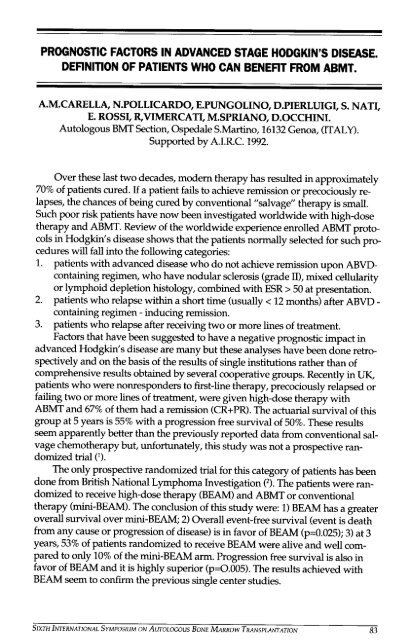VI Autologous Bone Marrow Transplantation.pdf - Blog Science ...
VI Autologous Bone Marrow Transplantation.pdf - Blog Science ...
VI Autologous Bone Marrow Transplantation.pdf - Blog Science ...
You also want an ePaper? Increase the reach of your titles
YUMPU automatically turns print PDFs into web optimized ePapers that Google loves.
PROGNOSTIC FACTORS IN ADVANCED STAGE HODGKIN'S DISEASE.<br />
DEFINITION OF PATIENTS WHO CAN BENEFIT FROM ABMT.<br />
A.M.CARELLA, N.POLLICARDO, E.PUNGOLINO, D.PIERLUIGI, S. NATI,<br />
E. ROSSI, R,<strong>VI</strong>MERCATI, M.SPRIANO, D.OCCHINI.<br />
<strong>Autologous</strong> BMT Section, Ospedale S.Martino, 16132 Genoa, (ITALY).<br />
Supported by A.I.R.C. 1992.<br />
Over these last two decades, modern therapy has resulted in approximately<br />
70% of patients cured. If a patient fails to achieve remission or precociously relapses,<br />
the chances of being cured by conventional "salvage" therapy is small.<br />
Such poor risk patients have now been investigated worldwide with high-dose<br />
therapy and ABMT. Review of the worldwide experience enrolled ABMT protocols<br />
in Hodgkin's disease shows that the patients normally selected for such procedures<br />
will fall into the following categories:<br />
1. patients with advanced disease who do not achieve remission upon ABVDcontaining<br />
regimen, who have nodular sclerosis (grade II), mixed cellularity<br />
or lymphoid depletion histology, combined with ESR > 50 at presentation.<br />
2. patients who relapse within a short time (usually < 12 months) after ABVD -<br />
containing regimen - inducing remission.<br />
3. patients who relapse after receiving two or more lines of treatment.<br />
Factors that have been suggested to have a negative prognostic impact in<br />
advanced Hodgkin's disease are many but these analyses have been done retrospectively<br />
and on the basis of the results of single institutions rather than of<br />
comprehensive results obtained by several cooperative groups. Recently in UK,<br />
patients who were nonresponders to first-line therapy, precociously relapsed or<br />
failing two or more lines of treatment, were given high-dose therapy with<br />
ABMT and 67% of them had a remission (CR+PR). The actuarial survival of this<br />
group at 5 years is 55% with a progression free survival of 50%. These results<br />
seem apparently better than the previously reported data from conventional salvage<br />
chemotherapy but, unfortunately, this study was not a prospective randomized<br />
trial 0).<br />
The only prospective randomized trial for this category of patients has been<br />
done from British National Lymphoma Investigation ( 2<br />
). The patients were randomized<br />
to receive high-dose therapy (BEAM) and ABMT or conventional<br />
therapy (rnini-BEAM). The conclusion of this study were: 1) BEAM has a greater<br />
overall survival over rnini-BEAM; 2) Overall event-free survival (event is death<br />
from any cause or progression of disease) is in favor of BEAM (p=0.025); 3) at 3<br />
years, 53% of patients randomized to receive BEAM were alive and well compared<br />
to only 10% of the rnini-BEAM arm. Progression free survival is also in<br />
favor of BEAM and it is highly superior (p=O.005). The results achieved with<br />
BEAM seem to confirm the previous single center studies.<br />
SIXTH INTERNATIONAL SYMPOSIUM ON AUTOLOGOUS BONE MARROW TRANSPLANTATION 83

















